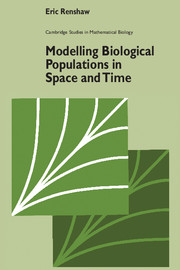
-
Select format
-
- Publisher:
- Cambridge University Press
- Publication date:
- 05 August 2012
- 26 July 1991
- ISBN:
- 9780511624094
- 9780521448550
- Dimensions:
- Weight & Pages:
- Dimensions:
- (228 x 152 mm)
- Weight & Pages:
- 0.597kg, 424 Pages
You may already have access via personal or institutional login
Book description
This volume develops a unifying approach to population studies, emphasising the interplay between modelling and experimentation. Throughout, mathematicians and biologists are provided with a framework within which population dynamics can be fully explored and understood. Aspects of population dynamics covered include birth-death and logistic processes, competition and predator-prey relationships, chaos, reaction time-delays, fluctuating environments, spatial systems, velocities of spread, epidemics, and spatial branching structures. Both deterministic and stochastic models are considered. Whilst the more theoretically orientated sections will appeal to mathematical biologists, the material is presented so that readers with little mathematical expertise can bypass these without losing the main flow of the text.
Reviews
"...an excellent introduction to the world of deterministic and stochastic models for population growth, both for students of applied mathematics and statistics at the undergraduate and postgraduate level and for advanced students of theoretical biology." Andris Abakuks, Mathematical Reviews
"An excellent reference for the class of mathematical models that it considers....The quality of the book is high....As an applied statistician with an interest--and some background--in the models discussed, I found the book easy to read, extremely useful, and its perspective sensible. It is well worth its price." Judy Zeh, Journal of the American Statistical Association
Contents
Metrics
Altmetric attention score
Full text views
Full text views help Loading metrics...
Loading metrics...
* Views captured on Cambridge Core between #date#. This data will be updated every 24 hours.
Usage data cannot currently be displayed.
Accessibility standard: Unknown
Why this information is here
This section outlines the accessibility features of this content - including support for screen readers, full keyboard navigation and high-contrast display options. This may not be relevant for you.
Accessibility Information
Accessibility compliance for the PDF of this book is currently unknown and may be updated in the future.


